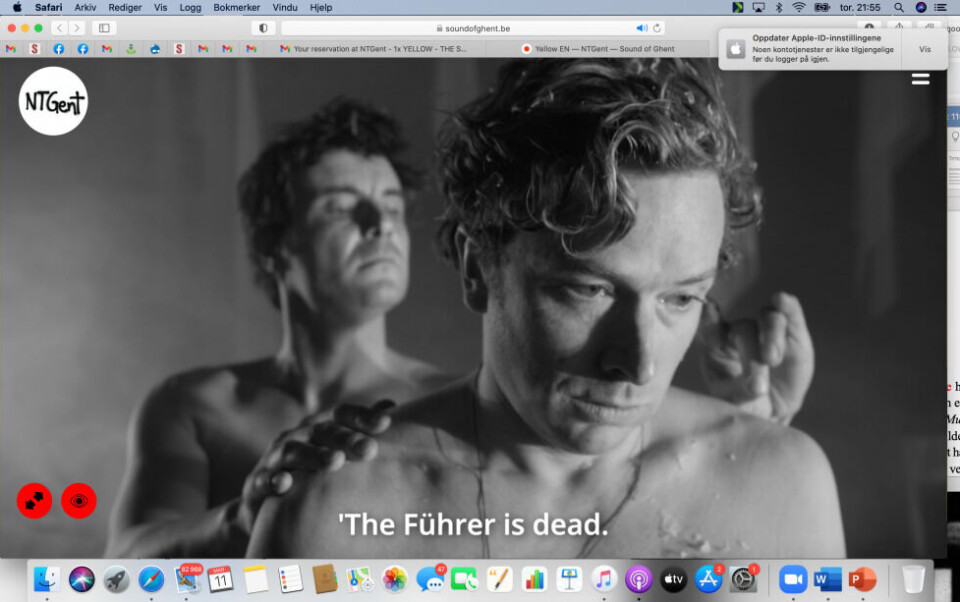
Close and distant at once
As it happened everywhere, Luk Perceval’s new production «Yellow», the second part of his Belgian trilogy, has been postponed not only once. In order to make progress and bring it to the public, Perceval and NT Gent decided for the premiere of its filmversion, based on filmed run-throughs and edited after aesthetic principles that have developed over decades in the works of the Belgian director.
Two years ago Perceval premiered the first part of his Belgian trilogy, Black, a dark exploration of the colonial past in Congo. Now, Yellow (the
colors of the trilogy will compose the national flag in the end) is devoted to another problematic chapter of Belgian history. Fascist movements of the 1930s and the collaboration with Nazi Germany belong to a contradictory complex with long-lasting effects even up to the present. The collaboration of mostly Flemish people resulted in some 10,000 troops in the service of the German Wehrmacht invading the Soviet Union. Behind the facts of such active recruitment lies a web of ideological aberrations rooted in earlier historical periods of the country located between France and Germany, most of all the idea that a Germanic union could bring into existence something like the Greater Netherlands of all Dutch-speaking regions. A strange concept never favoured by Hitler.
The play itself is a family story at war times in the first place, embedded in this historical context from the 1930s to the end of WWII and beyond. The Flemish Goenmaere family’s father, Staf, is a member of the Dietse Militia to picture the development of a fascist movement inside a household somewhere in Flanders. His son Jef, who is absent throughout the play, is one of those volunteers of the Flemish Legion sent to the war in the East and present with his letters from the front that he signs, strangely enough for private correspondence, with ‘Heil Hitler’. The Goenmaere women are not so far away from this political orientation. Mother Marije may be less enthusiastic about the involvement with the German war than her daughter Mie, but with utmost outrage she states that “the operetta state called Belgium has never lived in the hearts”. Staf’s brother, Hubert, can be seen as opposed to such attitudes while a priest, Uncle Laurens, remains close to the more or less patriotic ideas To extend this family panorama, playwright Peter van Kraaij has added two extremely sinister historical figures, the Austrian SS officer Otto Skorzeny and the even more illustrious Léon Degrelle, the Walloon founder of the fascist Rexist party - hence the title! Thus the family drama is cokmbined with documentary elements.
Minimalistic

Perceval seems to develop the sparse, minimalistic style for the play from the material it comes from: newspapers, letters and photographs scattered across a billiard table that could already be seen in Annette Kurz’s stage for Black. The table might be thus a kind of research platform but also the center of the family, or the Russian winter battlefield covered with snowflakes and the stage for political speeches such as that one by Degrelle explaining the idea of Walloons being a Germanic tribe from the borderlands. On such occasions an army of white flags surrounds the table and the characters start marching along the rhythms of Sam Gysel’s score between drum-beats and elegiac sounds.
A constant shift from the private yet political world of the Goenmaeres with the greater historical forces around them characterizes the staging, with an intense peak when the story touches upon Hubert’s help for a young Jewish woman living in underground in Antwerp during occupation. As it was in FRONT in 2014, a meaningful juxtaposition of altogether four languages can be heard, Dutch, German, French and English, each of them signifying not only the speaker’s mind but also their world and way of thinking, and, of course, to a large extent the composition of the international cast. In the last scene, Skorzeny and Degrelle exchange their recollections about Hitler, with bleak irony, in English while being sheltered in Franco’s Spain after the war.
Black and White/ Colour
The streaming version uses close-ups as a principal mode of filming most of the stage action, close to the superb ensemble with Peter Seynaeve, Chris Thys, Lien Wildemeersch, Bert Luppes, Maria Shulga, Oscar Van Rompay, Philip Leonhard Kelz and Valéry Warnotte. Director of photography Daniel Demoustier’s camera is nevertheless flexible to capture the space that looks like a black-box studio.
The streaming is no live recording from the tehatre, instead Perceval’s carefully edited montage uses color for the first and final scenes, and black-and-white for the main parts to make them appear as more distant and, paradoxically with all increased intensity, closer to the actors. (Published 0312.2021)
